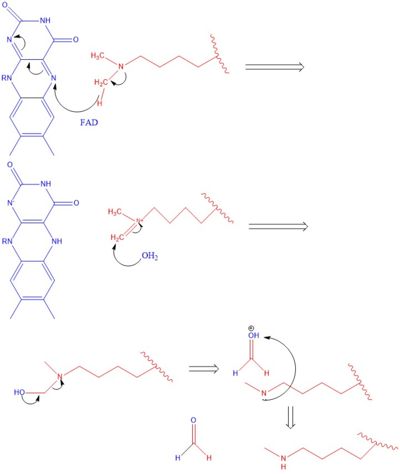User:Steve Klimcak/Sandbox 1
From Proteopedia
(Difference between revisions)
| Line 12: | Line 12: | ||
== Function == | == Function == | ||
===Mechanism=== | ===Mechanism=== | ||
| - | The demethylation of lysine via LSD1 occurs through oxidation via a hydride transfer. Shown in Figure 2 the first step involves the <scene name='81/811710/Fad_highlight/1'>Flavin Adenine Dinucleotide cofactor</scene> initiating a hydride transfer from the one of the two methyl groups bound to the nitrogen at the lysine tail, via a N5 on the flavin group. An imine cation is then formed at the end of the lysine tail to compensate for the loss of hydride. The FAD co-factor is also negatively charged and | + | The demethylation of lysine via LSD1 occurs through oxidation via a hydride transfer. Shown in Figure 2 the first step involves the <scene name='81/811710/Fad_highlight/1'>Flavin Adenine Dinucleotide cofactor</scene> initiating a hydride transfer from the one of the two methyl groups bound to the nitrogen at the lysine tail, via a N5 on the flavin group. An imine cation is then formed at the end of the lysine tail to compensate for the loss of hydride. The FAD co-factor is also negatively charged and lysine residue 661 provides stability by drawing that charge away. In the next step the imine is hydrolyzed and transitions to an hemiaminal. This then breaks down to formaldehyde and the product lysine. |
[[Image:LSD1 Mech.jpg|400px|right|thumb|Figure 2]] | [[Image:LSD1 Mech.jpg|400px|right|thumb|Figure 2]] | ||
Revision as of 17:08, 19 April 2019
LSD Demethylase
| |||||||||||
References
- ↑ Hanson, R. M., Prilusky, J., Renjian, Z., Nakane, T. and Sussman, J. L. (2013), JSmol and the Next-Generation Web-Based Representation of 3D Molecular Structure as Applied to Proteopedia. Isr. J. Chem., 53:207-216. doi:http://dx.doi.org/10.1002/ijch.201300024
- ↑ Herraez A. Biomolecules in the computer: Jmol to the rescue. Biochem Mol Biol Educ. 2006 Jul;34(4):255-61. doi: 10.1002/bmb.2006.494034042644. PMID:21638687 doi:10.1002/bmb.2006.494034042644
- ↑ Ransey E, Paredes E, Dey SK, Das SR, Heroux A, Macbeth MR. Crystal structure of the Entamoeba histolytica RNA lariat debranching enzyme EhDbr1 reveals a catalytic Zn(2+) /Mn(2+) heterobinucleation. FEBS Lett. 2017 Jul;591(13):2003-2010. doi: 10.1002/1873-3468.12677. Epub 2017, Jun 14. PMID:28504306 doi:http://dx.doi.org/10.1002/1873-3468.12677
- ↑ Khalid MF, Damha MJ, Shuman S, Schwer B. Structure-function analysis of yeast RNA debranching enzyme (Dbr1), a manganese-dependent phosphodiesterase. Nucleic Acids Res. 2005 Nov 7;33(19):6349-60. doi: 10.1093/nar/gki934. Print, 2005. PMID:16275784 doi:http://dx.doi.org/10.1093/nar/gki934
- ↑ Abdel-Magid AF. Lysine-Specific Demethylase 1 (LSD1) Inhibitors as Potential Treatment for Different Types of Cancers. ACS Med Chem Lett. 2017 Oct 27;8(11):1134-1135. doi:, 10.1021/acsmedchemlett.7b00426. eCollection 2017 Nov 9. PMID:29152043 doi:http://dx.doi.org/10.1021/acsmedchemlett.7b00426

